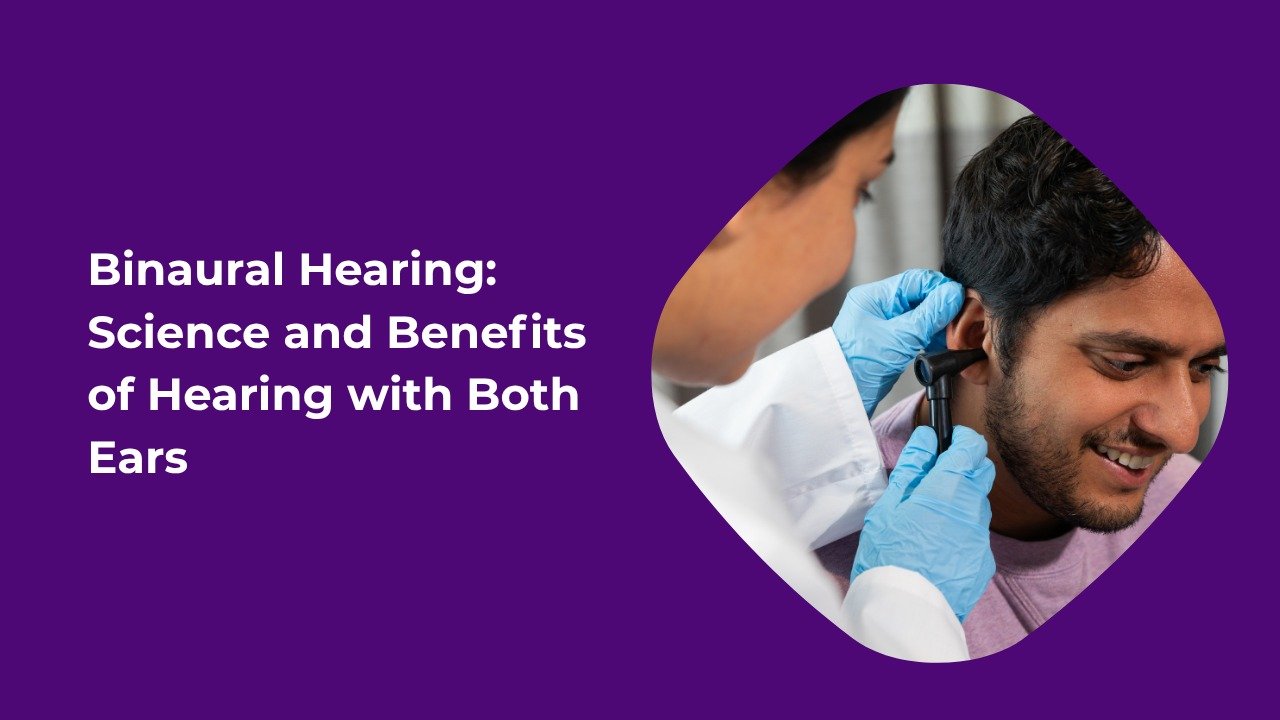What Is Binaural Hearing?
Binaural hearing refers to the ability to hear sound with both ears. This natural function allows the brain to process sound input from the left and right ears, helping us identify the direction of sound sources, improve speech clarity in noise, and perceive a richer acoustic environment. Binaural hearing is different from monaural hearing, where sound is received in only one ear, often due to hearing loss or the use of a single hearing aid.
Does Binaural Mean Both Ears?
Yes. “Binaural” literally means “relating to both ears.” It describes how humans use two ears simultaneously to detect, differentiate, and interpret sound signals.
How Binaural Hearing Works
Sound Localization and Spatial Awareness
The human brain can pinpoint the origin of sounds due to subtle differences in:
- Time of Arrival (Interaural Time Difference – ITD): Sound reaches one ear milliseconds before the other.
- Sound Intensity (Interaural Level Difference – ILD): The ear closer to the sound source receives a slightly louder signal.
- Phase Differences: Differences in the sound wave phase when it reaches each ear help with fine localization.
Together, these factors enable precise horizontal sound localization, which is the ability to determine where a sound is coming from left to right.
Where Does Binaural Hearing First Occur?
Binaural hearing begins in the brainstem, specifically in the superior olivary complex. This structure compares the signals from both ears and helps the brain identify timing and intensity differences, essential for sound localization.
What Is the Physiology of Binaural Hearing?
The auditory pathway involves several structures:
- Cochlea (inner ear): Converts sound waves into electrical signals.
- Auditory nerve: Transmits signals to the brainstem.
- Superior olivary complex: First site of binaural integration.
- Inferior colliculus and auditory cortex: Further process the binaural cues to interpret speech, direction, and sound quality.
Why Binaural Hearing Matters in Daily Life
Understanding Speech in Noisy Environments
In everyday settings like restaurants, streets, or social gatherings, noise often overlaps with speech. Binaural hearing improves the Signal-to-Noise Ratio (SNR), making it easier to focus on desired sounds, such as a person speaking, even when background noise is present.
Detecting Sound Direction
Accurately locating where a sound is coming from is vital for safety and communication. Whether it’s hearing a car honk, someone calling your name, or a doorbell ringing, binaural hearing lets you instinctively turn toward the sound source.
Spatial Sound Perception
With both ears working together, the brain creates a 3D acoustic picture of the environment. This ability enhances depth perception and makes the auditory experience more natural.
Binaural Hearing and Hearing Loss
Hearing loss in one or both ears disrupts the natural binaural process. When only one ear functions well or is aided with a hearing device, sound localization and speech understanding often suffer.
Difference Between Bilateral and Binaural Hearing
- Binaural hearing: Natural hearing with both ears or the simulated experience using bilateral hearing aids.
- Bilateral hearing: Refers to using hearing aids in both ears to restore the benefits of binaural hearing.
The Importance of Bilateral Hearing Aid Fittings
For individuals with hearing loss in both ears, using two hearing aids (bilateral fitting) is typically more beneficial than using just one (unilateral fitting). Here’s why:
1. Improved Speech Intelligibility
When both ears receive sound input, the brain can combine signals and better distinguish speech from background noise. This is especially helpful in environments with multiple sound sources.
2. Access to Head Diffraction Benefits
When sound and noise originate from different directions, each ear receives a different SNR. If only one ear is aided, the unaided ear may have the better SNR, but the listener can’t use that advantage. With two hearing aids, the brain can choose the better signal.
3. Binaural Squelch Effect
The binaural squelch effect is the brain’s ability to use differences in timing and loudness between ears to improve understanding of speech in noisy settings. This effect works best when low-frequency sounds are aided in both ears.
4. Binaural Redundancy
When both ears receive the same auditory information, the brain processes it more accurately and efficiently. This redundancy improves clarity and listening comfort.
5. Less Listening Fatigue
Hearing with only one ear can be mentally exhausting. Bilateral fittings balance the workload and reduce cognitive strain, especially during prolonged conversations or noisy environments.
6. Balanced Sound Perception
Bilateral hearing restores a sense of balance in hearing. Without it, many users report feeling off-center or disoriented, especially when navigating busy or unfamiliar places.
When Is Bilateral Fitting Most Beneficial?
The benefits of using two hearing aids increase with the degree of hearing loss:
- Mild loss: Some benefit, but often manageable with one aid.
- Moderate to severe loss: Bilateral fitting becomes crucial for sound localization, speech clarity, and overall hearing comfort.
Common Questions About Binaural and Bilateral Hearing
What Is the Difference Between Bilateral Hearing and Binaural Hearing?
- Binaural hearing is the natural use of both ears for hearing.
- Bilateral hearing is the use of hearing aids in both ears to mimic binaural hearing when natural hearing is impaired.
Why Is Binaural Hearing Aid Amplification Important?
Binaural amplification improves speech clarity, spatial awareness, and reduces the mental effort needed to listen. It helps the brain process and interpret sounds more naturally.
What Are the Benefits of Bilateral Hearing?
- Better speech recognition in noise
- Enhanced sound localization
- More natural sound quality
- Reduced listening fatigue
- Balanced hearing experience
Clinical Backing and Research
Multiple studies have shown that bilateral hearing aids offer measurable improvements in:
- Speech discrimination scores
- Sound localization accuracy
- Reported satisfaction and comfort levels
According to the American Academy of Audiology, most people with bilateral hearing loss benefit significantly more from two hearing aids than from one.
When Might a Unilateral Fitting Be Appropriate?
There are situations where one hearing aid may be sufficient:
- One ear has normal or near-normal hearing.
- One ear has very poor speech discrimination even with amplification.
- Cost or cosmetic concerns limit access to a second aid.
In such cases, hearing professionals may suggest a CROS (Contralateral Routing of Signals) system, which transfers sound from the non-hearing side to the functioning ear.
Tips for Maximising the Benefits of Binaural Hearing
- Use hearing aids consistently in both ears if prescribed.
- Get regular adjustments to ensure amplification matches current hearing levels.
- Practice listening in different environments to train the brain.
- Avoid environments with excessive noise when first adjusting to hearing aids.
External Resources
- American Academy of Audiology
- Hearing Loss Association of America
- National Institute on Deafness and Other Communication Disorders
Final Thoughts
Binaural hearing is not just a biological function—it’s essential for communication, safety, and navigating the world. For individuals with hearing loss, restoring binaural capabilities through bilateral hearing aids can significantly improve quality of life. Choosing the right hearing aid strategy in consultation with a hearing care professional ensures not only better hearing but also reduced stress, improved relationships, and enhanced daily experiences.





